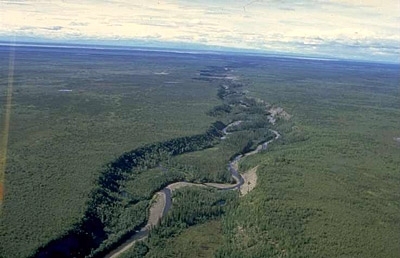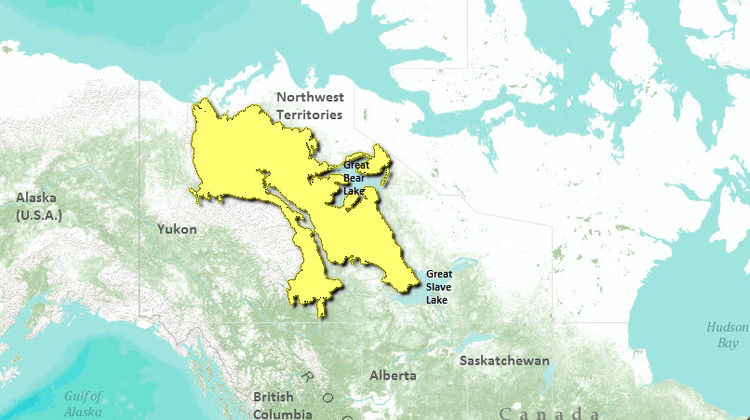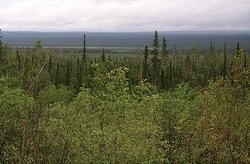Northwest Territories taiga
This ecoregion comprises the northern Mackenzie River Valley and areas to both the west and east of the lower Mackenzie Valley in the Northwest Territories. Much of the area to the south and west of Great Bear Lake is also included.
The climate in this ecoregion is marked by short, cool summers and long, cold winters. The mean annual temperature ranges between -10°C in the Mackenzie Delta region to -1°C in southern regions. Mean winter temperature ranges considerably from -26.5°C in the north to -1°C in the south, and mean summer temperature ranges from 6.5°C to 14°C. Mean annual precipitation is low, ranging 200-400 millimeters (mm), but reaching 500 mm in the southwest. This ecoregion is characterized by both low subarctic and high subarctic ecoclimates.
This ecoregion is the northern extension of the flat Interior Plains which dominate the Prairie and Boreal Plains ecoregions to the south. The broad lowlands and plateaus are incised by major rivers. The area is underlain by horizontal sedimentary rock, and is nearly level to gently rolling in topography.
Biological Distinctiveness
Vegetation consists of open, very stunted stands of black spruce (Picea mariana). The shrub component includes dwarf birch (Betula sp.), Labrador tea (Ledum decumbens), and willow (Salix spp.). Understory species include bearberry, mosses, and sedges. Upland and foothills areas, and southern [[region]s] are often better drained, are warmer, and support mixedwood forests characterized by white and black spruce (Picea glauca), lodgepole pine (Pinus contorta), tamarack (Larix laricina), white birch (Betula spp.), quaking aspen (Populus tremuloides), and balsam poplar (Populus balsamifera). White spruce and balsam poplar grow to greater heights along large rivers. Low-lying wetlands cover 25-50 percent of the ecoregion.
Characteristic wildlife of the Taiga ecoregion are woodland caribou (Rangifer tarandus spp. caribou), moose (Alces alces), bison (Bison bison), wolf (Canis lupus), black bear (Ursus americanus), marten (Martes americana), lynx (Lynx canadensis), and Arctic ground squirrel (Spermophilus parryi). Caribou overwinter in the northwest corner of the region. Bird species include the common redpoll (Carduelis flammea), gray jay (Perisoreus canadensis), common raven (Corvus corax), red-throated loon (Gavia stellata), northern shrike (Lanius excubitor), sharp-tailed grouse (Tympanuchus phasianellus), fox sparrow (Passerella iliaca), bald eagle (Haliaeetus leucocephalus), peregrine falcon (Falco peregrinus), osprey (Pandion haliaetus), and migratory waterfowl.
Seasonal flooding and forest fire are important natural disturbance features in this ecoregion.
This ecoregion was a possible Pleistocene refugia for some plant species. Intact vertebrate population densities in this ecoregion are in the natural range of variation.
Conservation Status
Habitat Loss and Degradation
Approximately 90 percent of the habitat remains intact. Most habitat loss is the result of disturbance around small communities, seismic lines throughout the region, and oil and gas development in the Norman Wells area. Small-scale logging in the south end of the ecoregion is occurring.
Remaining Blocks of Intact Habitat
Most of the ecoregion is intact.
Degree of Fragmentation
Fragmentation of habitat resulting from human disturbance is low. A year-round travel route planned for the MacKenzie Valley could cause disruption to some seasonal wildlife movement. Wildfire, a major natural disturbance in this ecoregion, creates a mosaic of vegetation communities across the landscape.
Degree of Protection
- Nahanni National Park - western Northwest Territories - 4,765.6 square kilometers (km2)
Types and Severity of Threats
Mining, oil, and gas development and the associated exploration phases of these industries are serious threats, in part due to the increased level of access created by the roading networks and seismic lines. The proposed northward extension of the Mackenzie Highway may create new pressures for wildlife populations in the northern portion of this ecoregion. Like many other northern ecoregions, a recent series of abnormal winters may mean that climate change is already creating significant seasonal changes to weather patterns.
Suite of Priority Activities to Enhance Biodiversity Conservation
- Additional protected areas are required that represent the ecological variation characteristic of this ecoregion.
- Candidate protected areas in the Peel River Plateau need to be designated in the Yukon portion of this ecoregion.
Conservation Partners
- Canadian Arctic Resources Committee
- Canadian Nature Federation
- Canadian Parks and Wilderness Society, Yukon Chapter
- Ecology North
- World Wildlife Fund Canada
- Yukon Conservation Society
| Disclaimer: This article is taken wholly from, or contains information that was originally published by, the World Wildlife Fund. Topic editors and authors for the Encyclopedia of Earth may have edited its content or added new information. The use of information from the World Wildlife Fund should not be construed as support for or endorsement by that organization for any new information added by EoE personnel, or for any editing of the original content. |


